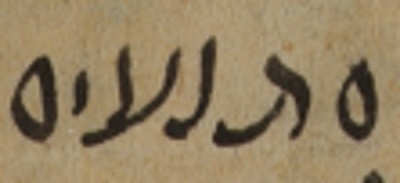Ḥalfon’s wife, Mosseri Ia.29
Ḥalfon b. Menasseh b. al-Qaṭāʾif is probably the most prolific writer of the Cairo Genizah. Many hundreds of legal documents and letters, from complete deeds to tiny fragments, were written by him and can often be recognised by the experienced researcher at first glance thanks to his distinctive and attractive hand writing. His unusual nickname Ibn al-Qaṭāʾif “of the sweetmeat”, probably the nickname of a female or male ancestor and reflecting either a sweet nature or an unusual predilection for the food, consequently became the nickname of the whole family.
While Ḥalfon is mainly known through his work as a court clerk and scribe of legal documents, we also find his private correspondence as well as that of his wider family. For some reason as yet unclear, the Mosseri collection holds a disproportionately large number of these private documents, many of which were composed by Ḥalfon's brother Yafet b. Menasseh b. al-Qaṭāʾif. The letters provide us with further details of Ḥalfon’s personal life and business undertakings.

Address of the letter (detail of verso)
The well-preserved letter Mosseri Ia.29 was written to Ḥalfon by his brother Yafet, and typically deals with a number of different matters, such as wares sent between the brothers and a certain Abū l-Surūr, instructions concerning a sum of money that had been sent, a payment to Ḥalfon's mother and correspondence with the qāḍī, an Islamic judge. As is usual with letters between close individuals, it can be difficult – nine hundred years later – to fully grasp matters that are often only alluded to. It is probable, though, that the letter touches upon a matter of inheritance.

Sitt Naʿīm, Ḥalfon’s wife (detail of recto)
The most interesting detail of the letter, however, is that it may reveal the name of Ḥalfon’s wife. Yafet sends greetings to a certain Sitt Naʿīm, which is unusual for a letter of the early 12th century. Only in the second half of the 12th century do women start to get a mention by name in Genizah documents; in earlier times explicit greetings to a woman or even the casual naming of a female member of the family were strictly taboo and a breach of etiquette. We can assume that Sitt Naʿīm was indeed Ḥalfon’s wife as the writer sends additional greetings earlier on in the letter to his mother and sisters. The unusual occurence of his wife’s name was probably due to the close kinship between the writer and recipient, both of whom were literate and practised writers, who had no need of an intermediary to pen their correspondence. Thus, in this highly personal and unfiltered communication, Ḥalfon and Yafet afford themselves a greater latitude of expression than we find in less intimate writings.
Readers are invited to send comments to genizah@lib.cam.ac.uk.
Bibliography
Weiss, Gershon: Legal Documents Written by the Court Clerk Halfon ben Menasse (Dated 1100–1138): A Study in the Diplomatics of the Cairo Genizah. PhD dissertation University of Pennsylvania 1970.
Goitein, S.D.: A Mediterranean society; the Jewish communities of the Arab world as portrayed in the documents of the Cairo Geniza; economic foundations. Berkeley 1967.
Edited to include links to the full manuscript (found here) in the Cambridge Digital Library (7 January 2013).
Cite this article
(2007). Ḥalfon’s wife, Mosseri Ia.29. [Genizah Research Unit, Fragment of the Month, July 2007]. https://doi.org/10.17863/CAM.40294
If you enjoyed this Fragment of the Month, you can find others here.
Contact us: genizah@lib.cam.ac.uk
